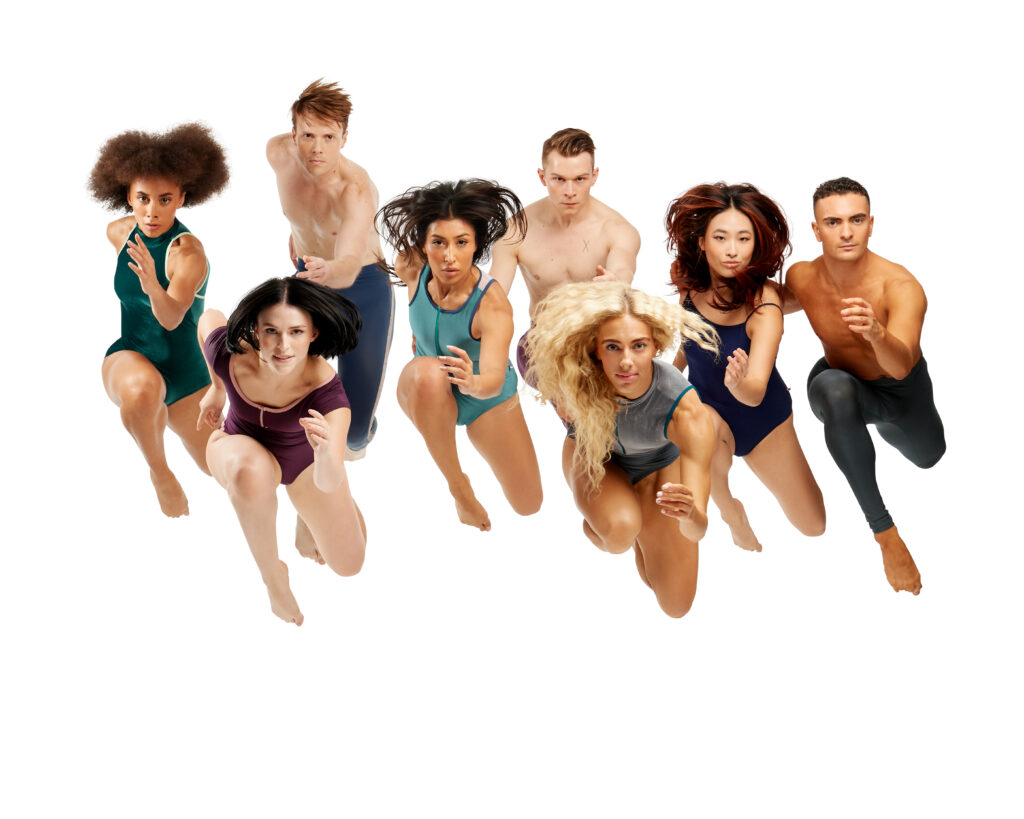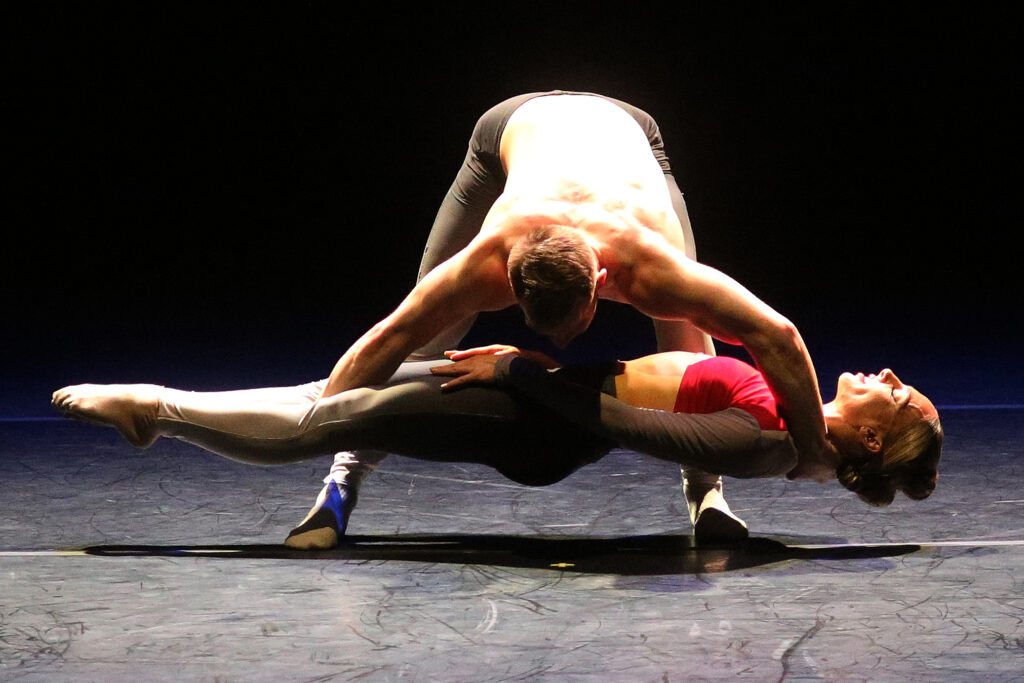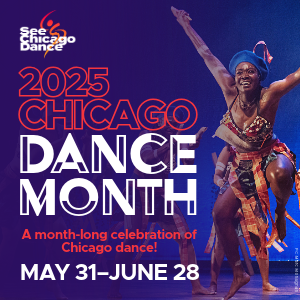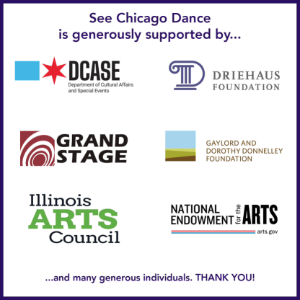April 14, 2025
By Maureen Janson
After a 30-year absence, Chicago warmly welcomed Parsons Dance to The Auditorium Theatre on Saturday for one night of mixed repertory. The athletic, entertaining, music-inspired program included a timeline of five works by 40-year artistic director, New York-based David Parsons, and a new piece by Alvin Ailey alum, Jamar Roberts.
The opening “Wolfgang” (2005), Parsons’ crisp romp set to Mozart music, leans heavily toward ballet, but with a distinctly contemporary flair. Three pairs of dancers chase each other, leap, lift and swirl like tightly wound tornadoes bathed in Howell Binkley’s golden and blue light. In repeated vertical lifts, a dancer slowly unfurls like a beautiful blooming flower as others lean away then rebound to start another bloom. A lone dancer stands as another spins with precision and speed in a perfect circle around him, like a top spinning on the edge of a glass. Couples advance and retreat in and out of illuminated rectangles on the floor, appearing and disappearing like lively apparitions and eventually disappearing all together as if the dance was just a dream.

In “Nascimento” (1990) the company sets in motion by a kiss. Wearing smiles and pastel swirling skirts and shirts, the nine company dancers provide plenty of non-stop eye candy. Here, one can sense Parsons’ roots with Paul Taylor in the elegant playful movement set to Milton Nascimento’s jazzy, Brazilian-rhythmic score. Boldly lit with orange and blue, silhouetted dancers pierce the air in diagonal shapes. The group holds hands and circle like friends in a children’s playground game. They jump repeatedly with legs bent to the side and cat paw hands facing forward. The initial kiss returns, morphing to a hug and setting off brief solo moments. Through precise lifts, leaps and cheerleader-ish tossing of dancers into the air, the piece sometimes articulates the distinct rhythms of the music and other times flows broadly against it. But the dance beckons more dimension and variety, and the individuality of these friends begs to be seen. Just when it feels like the ensemble may disperse, they reunite arm in arm advancing upstage with a calmness not present in the piece until this final moment.
Roberts unique contribution, “Juke” (2024), creates a movement language of individuality. A sort of modern/funk blend of body isolations, hip articulations and flashy, athletic feats set to the music of Miles Davis, this full-throttle work introduces an other-worldly gang. Each dancer has a chance to shine, sliding across the floor in a super wide stance, gesturing as if shifting the gears of a car, conjuring up secret handshakes, shimmying shoulders and leaping to land impossibly in a one-legged full arabesque balance. The dynamic shifts as a lone dancer, taunted by the surrounding others, falls to the floor then quickly rises with growing frustration, wanting acceptance from the group wall enclosing in on him.

The fun full-company finale, “Shining Star” (2004), is all about energy rather than any deep revelation. Earth, Wind and Fire music drives Parsons’ now-recognizable clear style: a ballet-based fluid and playful concoction of runs, turns and lifts ebbing and flowing seamlessly from group to solo to duet. Dancers roll across the floor, circling each other without losing eye contact, creating a growing tension and connection. One dancer dives across the floor in a turning horizontal jump like a flung pair of scissors, then lands surprisingly and casually at the feet of his partner. The company feels relaxed in this piece, as they groove through an exaggerated line dance, lift each other overhead and cuddle in each other’s arms.
The group dance energy is infectious, but Parsons’ two smaller works resonate most. Listed as a solo in the program, the duet, “Balance of Power” (2020), feels influenced by Parsons’ days with Momix. Master shapeshifters Zoey Anderson and Joseph Cyranski embody the percussive score by Giancarlo de Trizio with extreme control and clarity. Crouched side by side like yogis, they slowly rise to standing, then to lifting. Cyranski holds Anderson in a planked horizontal position lowering her suspended a few inches from the floor like offering a precious gift. Anderson balances on Cyranki’s shoulders, pivoting her stiff torso and outstretched legs like some weird human seesaw. As details of the score become more ornate, the dancers pop and pulse their torsos as if their hearts might burst out of their ribs. Appearing almost inhuman, the two advance downstage reminding us they are just people after all.
Parsons’ iconic innovative “Caught” (1982), still holds awe. A bravura jump fest for dancer Anderson, “Caught” requires incredible endurance and timing. The magic of strobe lights repeatedly catch Anderson suspended in mid air, like watching a live a stop motion video in which the dancer never touches the ground. Anderson appears to literally fly across the stage one leg extended towards her ear, then stops abruptly, grounded and still as a statue. Miraculously, she levitates from side to side, legs crossed as if sitting on a cloud. Retreating quickly upstage like a floating alien paper doll giving a small wave goodbye, Anderson returns to earth and the piece ends too soon. We want more.
Parsons Dance performed at The Auditorium Theatre, 50 E Ida B. Wells, at 7:30pm. For more information visit parsonsdance.org.
Copyright 2025, See Chicago Dance, All Rights Reserved

